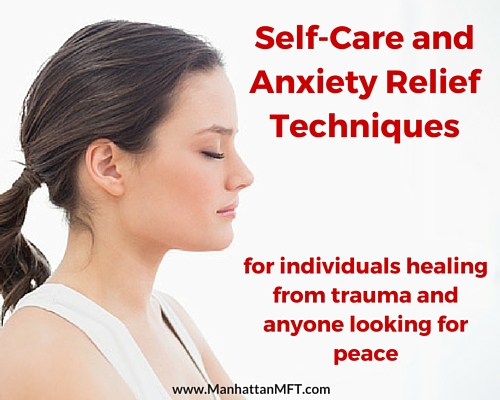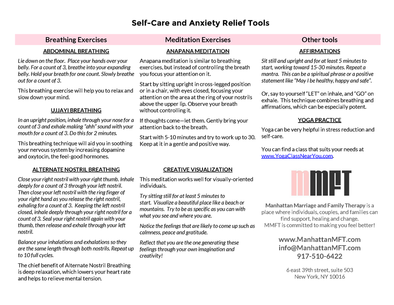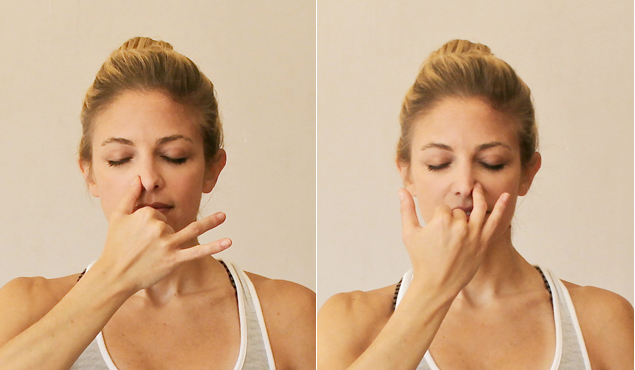It is for this reason that many Cognitive Behavioral Techniques for treating trauma or anxiety begin with self-care strategies that have roots in ancient yogic techniques. These include breathing techniques, meditation and yoga poses, which not only have physical benefits of reducing hyperarousal, but are also very helpful in re-framing negative mindsets.
For instance, Pantjanli’s YOGA SUTRAS written over 2500 years ago states: “When disturbed by disturbing thoughts—think of the opposite”, a technique that’s frequently used in therapeutic settings. Another similar CBT technique is one of stopping or cancelling self-defeating thoughts by just saying “STOP”.
Here is a primer to help you get started in these self-care techniques. You can download a printable version of this handy guide here.
Breathing Exercises
ABDOMINAL BREATHING Lie down on the floor. Place your hands over your belly. For a count of 3, breathe into your expanding belly. Hold your breath for one count. Slowly breathe out on a count of 3. This breathing exercise will help you to slow down. As you slow down your breath, your mind will begin to slow down as well. UJJAYI BREATHING Ujjayi Breathing means the “breath of the conqueror”. This breathing technique will aid you in soothing your nervous system by increasing dopamine and oxytocin, the feel-good hormones. In an upright position, inhale through your nose and exhale “ahh” through your mouth. Do this a few times and you will notice that the back of your throat closes off to make an ocean-like sound. Continue breathing through your nose: inhale for a count of 3 and exhale with an “ahh” sound for a count of 3 as well. Do this for 2 minutes. This breathing technique is most effective when practicing yoga or walking. ALTERNATE NOSTRIL BREATHING (NADI SHODANA) Begin in a comfortable, cross-legged position or seated upright in a chair. With your right hand, bend your index and middle fingers, keeping your ring finger, pinkie finger, and thumb extended. This hand position, or mudra, is called Mrigi Mudra.
age: Shape Magazine.
Close your right nostril with your right thumb. Inhale deeply for a count of 3 through your left nostril. Then close your left nostril with the ring finger of your right hand as you release the right nostril, exhaling for a count of 3. Keeping the left nostril closed, inhale deeply through your right nostril for a count of 3. Seal your right nostril again with your thumb, then release your left nostril. Exhale out of your left nostril. You should now be in the original position, with your thumb sealing your right nostril. This is one cycle. Balance your inhalations and exhalations so they are the same length through both nostrils. Repeat up to 10 full cycles, gradually increasing the number of repetitions as you gain experience. The chief benefit of Alternate Nostril Breathing is deep relaxation, achieved through balancing of the right and left hemispheres of the brain, the emotional (right) side and the rational (left) side. ANB lowers your heart rate and helps to relieve mental tension. As you practice Nadi Shodhana, shifting your awareness between your left and right nostrils, your mind naturally becomes more centered and focused. With regular practice, your attention span and ability to focus for long periods may be positively affected. Meditation Practices Meditation is an exercise for the mind. Mindfulness and concentration are the essence of meditation. Meditation has been scientifically proven to have a number of health benefits, including: increased immune function, relief of pain, easing anxiety and depression, improves memory, focus and attention. Here are two simple types of meditation you can start with. ANAPANA MEDITATION Anapana meditation is similar to breathing exercises, but instead of controlling the breath you focus your attention on it. Start by sitting upright in cross legged position or sitting in a chair, with eyes closed, focus your attention on the area at the ring of your nostrils above the upper lip. Observe your breath without controlling it. If thoughts come—let them, that is fine. Gently bring your attention back to the breath. Start with 5-10 minutes in the morning and see if you can work up to 30 minutes. Do not let yourself get discouraged: even if you focus on your breath for just a few moments without your mind wandering – this is progress. Keep at it in a gentle and positive way. CREATIVE VISUALIZATION This is a different type of meditation that may work well for someone who is visually-oriented. Try sitting still for at least 5 minutes to start. Visualize a beautiful place like a beach or mountains. Try to be as specific as you can with what you see and where you are. Notice the feelings that are likely to come up such as calmness, peace and gratitude. Reflect that you are the one generating these feelings through your own imagination and creativity!
AFFIRMATIONS
A recent study published in Psychological Science, a journal of the Association for Psychological Science, explored the neurophysiological impact of self-affirmations and the effect they have on our self-integrity. It has been my experience from being in a 10-day silent meditation retreat, where you are asked to sit for one hour without moving, I noticed that saying gentle and supportive phrases such as , “ I am proud of you”, “This is good”, “You can do it”, offers such more support than negative self-talk. In contrast, when I started thinking very negative things in these 1 hour “sits”, I became very restless and had to move! Sit still and upright and for at least 5 minutes to start, working toward 15-30 minutes. Repeat a mantra. This can be a spiritual phrase like “OM MANI PADME HUM” which is a traditional Tibet phrase for well-being. Or, you can repeat any positive statement like “May I be healthy, happy and safe”. Another exercise you can incorporate is to say to yourself “LET” on inhale, and “GO” on your exhale Repeat: Inhale- LET; Exhale –GO. This combines two techniques, breathing and affirmations, which can be especially potent. Yoga Practice There are many yoga asanas (positions) that are helpful in stress reduction and self-care. I recommend taking an instructed yoga classes to reduce chances of injury and increase chances of ongoing practice. I personally have taught vinyasa, a flowing yoga practice, which incorporates breathing techniques and is meditative in nature. You can find a yoga class near you at www.YogaClassNearYou.com. In conclusion, these ancient practices along with modern “talk” therapy can provide a highly effective way of healing and finding peace amidst the noise of our busy lives. Working in concert, these tools can deepen our understanding of ourselves, slow down and heal the wounds that hold us back. Download a free printable Tool Sheet!
Don't miss future posts! Sign up for our once-a-month e-mails.
12/28/2022 06:08:35 pm
Thanks so much for the tips on how to calm down when you're feeling anxious. My sister struggles with anxiety every day and it's gotten so bad that sometimes she can't function properly. We've been looking into finding someone she can see for counseling to help her cope and understand her brain. Comments are closed.
|
Categories
All
Archives
March 2023
|
[email protected]




 RSS Feed
RSS Feed